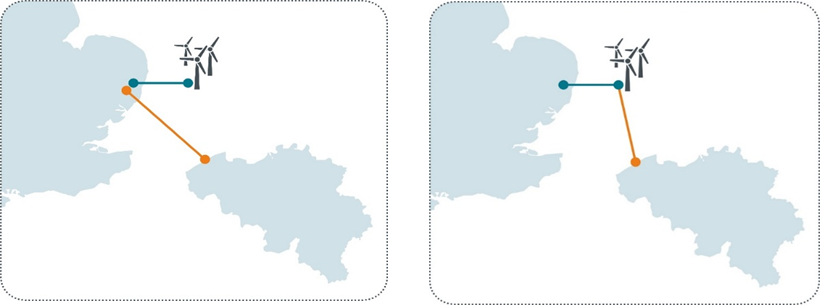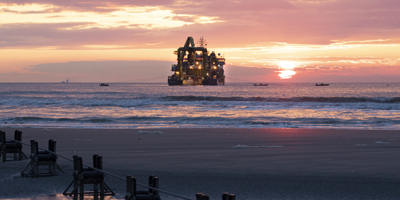Nautilus
The Nautilus project covers the construction of a second subsea interconnector between Belgium and the United Kingdom.

Power bridge between land and sea. Nautilus will transport electricity between Belgium and UK while facilitating offshore wind connections in the North Sea
The Belgian and UK power grids are already connected via the Nemo Link® interconnector. Now, Elia and National Grid Ventures (NGV) are looking into building a subsea hybrid interconnector between Belgium and the UK: Nautilus.
The Nautilus hybrid interconnector would have two functions: connecting the grids of both countries and directly connecting offshore wind farms to the mainland. Not only would it enable better integration of renewable energy at sea, but would also allow more volatile electricity flows in Europe while further enhancing electricity price convergence.
The European Commission, which recognises the project's importance in a European context, has already called Nautilus a project of common interest (PCI). In this connection, the European Commission supports cross-border infrastructure projects that connect countries' energy systems while helping the EU implement its energy policy and achieve its climate goals.
-
Efficient, sustainable and reliable power grid
A hybrid interconnector between Belgium and the UK can make energy more sustainable, reliable and affordable for consumers. Nautilus could contribute towards:
- Promoting the use of renewable energy
Europe wants to be completely CO2-neutral by 2050, a goal that requires generating more renewable energy. These green ambitions (taking the form of the European Green Deal) are shared by Belgium and endorsed by Elia. Developing power generation and exchange via the North Sea is extremely important for achieving these goals. - Supporting security of supply
In our complex energy system, supply and demand must be kept balanced at all times. Since renewable wind and solar power cannot yet be stored on a large scale, it is necessary to be able to exchange electricity at the right time. For example, if Belgium's own electricity generation were low, it could import electricity from the United Kingdom via Nautilus. And if wind farms off the Belgian coast were producing a lot of electricity, but demand in Belgium were low, then those surpluses could be exported to the UK. - Bolstering market exchange capacity
Supply and demand could be better aligned by developing hybrid interconnectors. This would enhance market exchange capacity and lower costs, which in turn would have a positive effect on energy prices.
- Promoting the use of renewable energy
-
Research
There are two types of offshore interconnectors.
1. Point-to-point interconnector
In a conventional radial interconnector, Belgium and the UK are connected directly to each other via a subsea high-voltage direct-current (HVDC) cable.2. Hybrid interconnector
In a hybrid interconnector, the interconnector has two functions: exchanging electricity between Belgium and the UK and transmitting electricity from offshore wind farms to the mainland. This is made possible by linking the interconnector via direct current (HVDC) to wind farms in the North Sea.

In 2020 it was decided that Nautilus would be a hybrid interconnector – if that proves cost-effective and entails environmental benefits. The European Commission notes that hybrid projects can be an intermediate step towards a fully meshed electricity grid with multiple offshore nodes, which is necessary for being able to fully utilise the potential of the North Sea and exchanging sufficient electricity.
Elia and NGV are currently carrying out the necessary regulatory studies and market-related and technical studies needed to make the construction of Nautilus possible. These studies will have to determine, among other things, which route the interconnector will take, both on land and in the North Sea. -
Timetable
Nautilus is currently in the study phase. According to the current schedule, exchanging electricity via Nautilus will not be possible until 2028 at the earliest.
- 2019: Federal Development Plan (2020-2030)
- 2020-2021: Exploratory studies
- 2021-2024: Technical studies, permitting and tendering process
- 2025-2028: Construction phase
- 2028: Commissioning

News

01 September 2019
Second interconnector between Belgium and the UK
Contact us
If you are affected by a project and want to ask us something, please feel free to contact us.
Our team would be happy to help.

